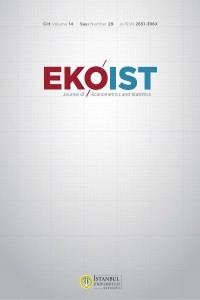AVRUPA PARASAL BİRLİĞİNDE KAMU BORÇ STOKU VE ENFLASYON İLİŞKİSİ: PANEL VERİ ANALİZİ
Avrupa Parasal Birlik, Fiyat Düzeyinin Mali Kuramı, Ricardocu ve Ricardocu Olmayan Mali Politikalar, Panel Veri Analizi
___
- Afonso, A. (2002) “Disturbing the Fiscal Theory of the Price Level: Can it Fit the EU-15”, http://econpapers.repec.org/cpd/2002/5-Afonso.pdf May 14, 2007.
- Afonso, A. (2005) “Ricardian Fiscal Regimes in the European Union”, Working Paper, No:558, European Central Bank, 1-44.
- Alstadheim, R. (2005) “Is the Price Level in Norway Determined by Fiscal Policy?”, Norges Bank, Working Paper, 5, 1-18.
- Baltagi, B. (2004) Econometric Analysis of Panel Data, Third Edition, New York: John Wiley and Sons. Bassetto, M. (2001) “Fiscal Theory of the Price Level”,
- http://www.nber.org/~
- bassetto/research/palgrave/ftheorypost.pdf March, 10 2007.
- Beck, N. & Katz, J. N. (1995) “What to do (and not to do) with Time-Series Cross-Section Data” The American Political Science Review, 89 (3):634-647.
- Bergin, P. (2000) “Fiscal Solvency and Price Level Determination in a Monetary Union”, Journal of Monetary Economics, 45, 37-53.
- Bloise, G. & P. Reichlin (2005) “Long-Term Public Debt and the Fiscal Theory of the Price Level”, http://www.cepr.org/pubs/dps/DP5479.asp July 15, 2007.
- Bohn, H. (1998) “The Behaviour of U.S. Public Debt and Deficits”, Quarterly Journal of Economics, 113, 949-963.
- Bravo, A. & Silvestre, A. (2002) “Intertemporal Sustainability of Fiscal Policies: Some Tests for European Countries”, European Journal of Political Economy, vol. 18, 517-528.
- Buiter, W. H. (1998) “The Young Person’s Guide to Neutrality, Price Level Interminancy, Interest Rate Pegs and Fiscal Theories of the Price Level”, Discussion Paper 1799, Centre for Economic Policy Research.
- Buiter, W. H. (2001) “The Fallacy of the Fiscal Theory of the Price Level, Again”, Working Paper 141, Bank of England.
- Canzoneri, M. B., Cumby, R. E. & Diba, B. T. (2001) “Is the Price Level Determined by the Needs of Fiscal Solvency?”, American Economic Review, 91, 1221-1238.
- Carlstrom, M. B. & Fuerst, T. S. (2000) “The Fiscal Theory of The Price Level”, Federal Reserve Bank of Clevand Economic Review, 36, No:1, 22-32.
- Claeys, P. (2007) “Sustainability of EU Fiscal Policies:A Panel Test”, Institut de Recerca en Economia Aplicado, 1-24.
- Cochrane, J. H. (1998) “A Frictionless view of U.S. Inflation”, NBER Macroeconomics Annual, 13, 323-384.
- Cochrane, J. H. (2001) “Long-term Debt and Optimal Policy in the Fiscal Theory of the Price Level”, Econometrica, 69, 69-116.
- Cochrane, J. H. (2005) “Money as Stock”, Journal of Monetary Economics, 52, 501-528.
- Creel, J. & Bihan, H. L. (2001) “Using Structural Balance Data-to Test the Fiscal Theory of the Price Level: An Application to France and the USA” http://repec.org/res2002/Creel.pdf June 14, 2007.
- Creel, J. & Kamber, G. (2004) “Debt, Deficits and Inflation on the Road to the EU: The Case of Turkey”, Special Case, 157-174.
- Daniel, B. C. (2001) “The Fiscal Theory of the Price Level in an Open Economy”, Journal of Monetary Economics, No:48, 293-308.
- De Resende, C. (2007) “Cross Country Estimates of the Degree of Fiscal Dominance and Central Bank Independence”, Bank of Canada, Working Paper, 36, 1-33.
- Dupor, B. (2000) “Exchange Rates and the Fiscal Theory of the Price Level”, Journal of Monetary Economics, No:45, 613-630.
- Ehrhart, C. & Llorca, M. (2007) “A Global Perspective of Fiscal Sustainability: Evidence from a panel of 20 OECD Countries”,
- http://www.socuoc.gr/makro/11conf/docc/Fiscal-sustainability-OECD-countries. pdf December 11, 2007.
- Favero, C. & Monacelli, T. (2003) “Monetary-Fiscal Mix and Inflation Performance: Evidence from U.S.”, CEPR, NBER and Universita Bocconi, 1-27. Holmes, M., Otero, J. & Panagiotidis, T. (2007) “Are EU Budget Deficits Sustainable?”,http://www.commerce.otago-ac.nz/econ/seminars/Abstracts/Mark %20Holmes %20September 2007-%20.paper.pdf December 11, 2007.
- Janssen, N.; Nolan, C. & Ryland, T. (1999) “Money, Debt and Prices in the UK, 1705-1996”, http://www.reading.oc.uk/business/ images/content/emdp4108 .pdf June 18, 2007.
- Leeper, E. M. (1991) “Equilibria under “Active” and “Passive” Monetary and Fiscal Policies”, Journal of Monetary Economics, 27, 129-147.
- McCallum, B. T. (2001) “Indeterminancy, Bubbles and the Fiscal Theory of Price Level Determination”, Journal of Monetary Economics, 47, 19-30.
- Prohl, S. & Schneider, F. (2006) “Sustainability of Public Debt and Budget Deficit: Panel Cointegration Analysis for the European Union Member Countries” http://www.econ.jku.at/papers/2006/wp0610.pdf September 1, 2007.
- Rubio, O., Diaz-Roldan, C. & Esteve, V. (2007) “Deficit Sustainability and Inflation in EMU: An Analysis from the Fiscal Theory of the Price Level”, http://www.ief.es/publicaciones/PapelesDeTrabajo/pt2007_02.pdf September 3, 2007.
- Semmler, W. & Zhang, W. (2004) “Monetary and Fiscal Policy Interactions in the Euro Area”, Empirica, 31, 205-227.
- Sims, C. A. (1994) “A Simple Model for Study of the Determination of the Price Level and the Interaction of Monetary and Fiscal Policy, Economic Theory, 4, 381-399. Sims, C. A. (1997) “Fiscal Foundations of Price Stability in Open Economies”, http://sims.princeton.edu/yftp/hongkong/hkbrown.pdf April 4, 2007.
- Thams, A. (2007) “The Relevance of the Fiscal Theory of the Price Level Revisited”, Munich Personel Repec Archive, 1-20.
- Tkocevs, A. (2007) “The Relevance of the Fiscal Theory of the Price Level Revisited”, Munich Personel Repec Archive, 1-20.
- Vieria, C. (2000) “Are Fiscal Deficits Inflationary: Evidence for the EU?, Economic Research Paper, Lougborough University, No:00/7, 1-17.
- Woodford, M. (1994) “Monetary Policy and Price Level Determinancy in a Cash-in-Advance Economy, Economic Theory, 4, 345-380.
- Woodford, M. (1995) “Price Level Determinacy Without Control of a Monetary Aggregate, Carnegie- Rochester Conference Series on Public Policy, 43, 1-46.
- Woodford, M. (1998) “Public Debt and the Price Level”, presented at the Bank of England Conference on Government Debt and Monetary Policy, June, 18-19.
- Woodford, M. (2001) “Fiscal Requirements for Price Stability”, Journal of Money, Credit and Banking, 33, 669-728.
- Yayın Aralığı: Yılda 2 Sayı
- Yayıncı: İstanbul Üniversitesi
AVRUPA PARASAL BİRLİĞİNDE KAMU BORÇ STOKU VE ENFLASYON İLİŞKİSİ: PANEL VERİ ANALİZİ
DÖVİZ KURU GETİRİ VOLATİLİTESİNİN KOŞULLU DEĞİŞEN VARYANS MODELLERİ İLE ÖNGÖRÜSÜ
Doç. Dr. Ebru ÇAĞLAYAN, Tuğba DAYIOĞLU
FORECASTING THE EXCHANGE RATE SERIES WITH ANN: THE CASE OF TURKEY
Doç. Dr. Cem KADILAR, Prof. Dr. Muammer ŞİMŞEK, Araş. Gör. Çağdaş Hakan ALADAĞ
